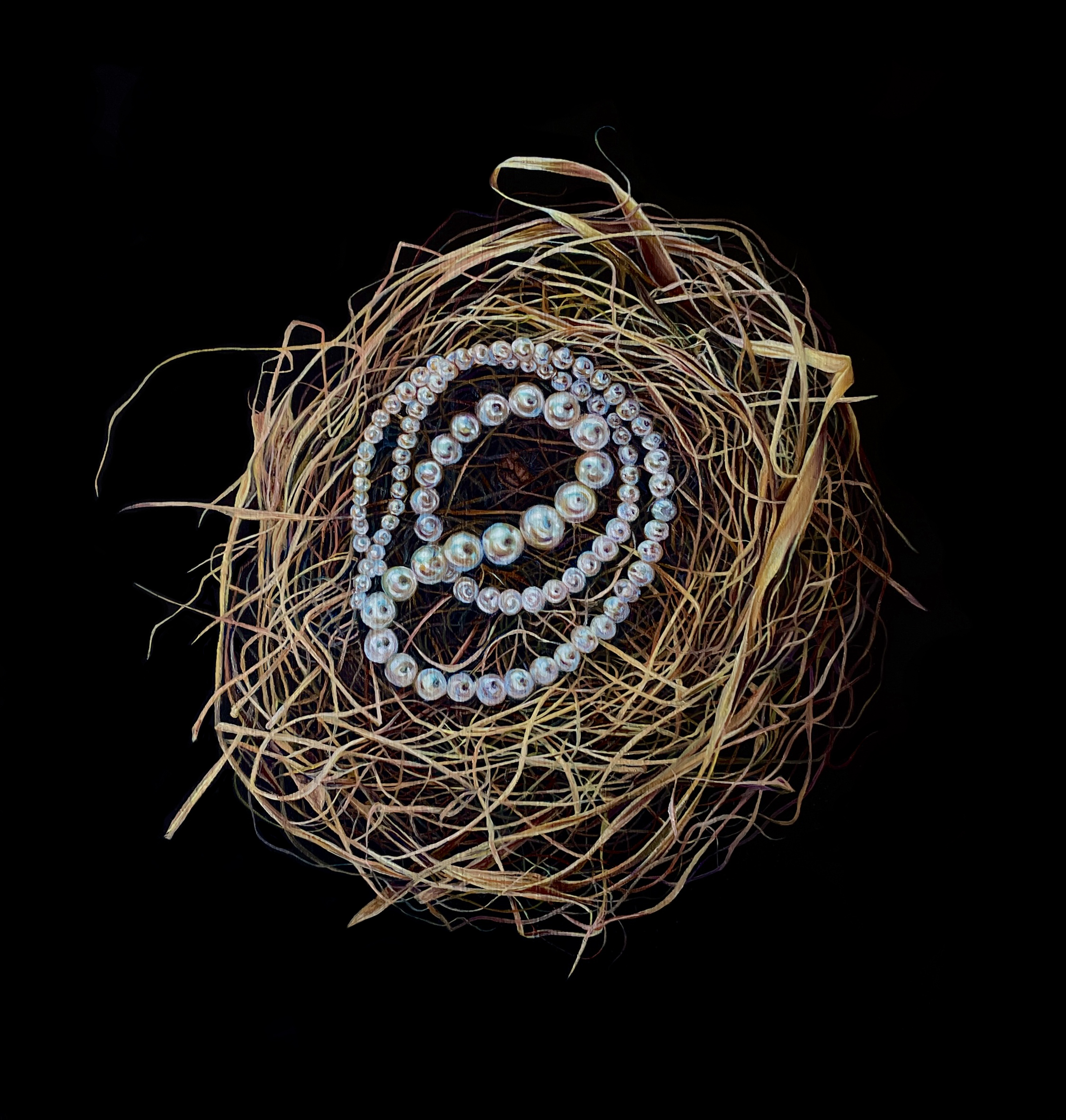I’d guess you have no idea who Tilly Woodward is. But you need to become acquainted with her, if only to understand something about the God whose eye is on the sparrow. Or since we’re talking Tilly here, the God whose eye is on the sparrow’s nest. And you will know what this season Advent heralds: the coming of a God who cares for the smallest details of human existence.

“Black Ball,” by Tilly Woodward
On the wall of our living room, we have a print of a small painting Tilly did of an old baseball she found on one of her regular walks that took her behind the outfield of a baseball diamond in her town. The ball’s red stitching stands out against the black background and next to the white leather with its many scuff marks and oil stains from pitchers’ hands. Tilly herself is as compact as her paintings, and in her home she has a basket of other found balls she’s claimed, most just as damaged, some with frayed stitching and innards beginning to spill out. Put one of those balls next to the painting, and you’d be hard-put to distinguish which is real. The chiaroscuro contrast and the great detail of the painting make her the Caravaggio of Iowa.
Better than the baseball print, however, is an actual Tilly Woodward painting my wife and I commissioned for our thirtieth wedding anniversary. The pandemic scuttled our planned British Isles trip, and we decided to spend the money on something more lasting and eminently more cherishable. Tilly titled this lovely, unassuming painting “Love Wins.” We’d seen many of her works in local galleries and online. Some of our favorites are paintings of found nests, and we asked that one be included in ours. In addition, since the thirtieth is the pearl anniversary, we asked that she find a way to have pearls present, too.
Our painting has a black background, and in the center is a nest that would fit in the palm of your hand. Tilly depicted every slender blade of dried field grass that some unknown bird grabbed in a beak and flew back to a tree to swirl into a home for her eggs. And not just each blade, but the subtle nuances of shading and ridges and bends to the blades. I’ve stood at the table in her home that Tilly uses as a studio, and I’ve seen her collection of brushes. Some are so small and fine that they consist of just a few sable hairs. That is what she used on the wispiest of these grasses so that the range of sizes together creates what’s nearly the platonic ideal of a nest.

“Love Wins,” by Tilly Woodward
Settled into the nest is a strand of silver pearls that gradually diminish in size as your eye moves around the coil. Each individual pearl, whether large or small, is a thing all on its own taking you toward something numinous. Through the representation created at a table in central Iowa, we apprehend an unknowable pearl-ness because the painted pearls so purely reflect the light that bounced around Tilly’s table as she worked her magic for us. Those literally nestled pearls surrounded by a found basket of grasses are an apt metaphor for our three decades together: serendipitous beauty settled within the rough swirl of life.
Such an intimate attention to detail is at the core of our Advent anticipation. We spend four weeks first looking forward to the enfleshment of a God who is so extraordinarily concerned with his human creatures that he nestles in among us. As John’s prologue puts it, the Word has pitched his tent with us. God in Christ is no disinterested psychologist merely observing his human experiment from behind a two-way mirror. Jesus is God heedlessly screwing up the results of the entire endeavor by inserting himself in the mix. The devil is not in the details. God is.
That babe in the feed box in Bethlehem concerned himself with the mundane details of life. The boy teaching the Temple elders knew nestling bird and star in heaven. The one who went down into the Jordan knew nacre and the sheen of reflected light. The friend at Lazarus’ tomb knew the minutiae of breathing in morning mist, racking gulps of griefs, and all our death rattles in his own body. The crucified one knows your hairs and mitochondria and digestive biome. The risen one knows your final (likely unsung and unnoticed save by a few) shift from life to death. He’s sunk deep in the grasses and oyster beds that the art that is you is made from.
In Advent we look as well to the return of the king. Yet the promise of his return bodes of more than merely Jesus present among his created details (although that is nothing to be discounted). It means that every last detail tainted by the unreality of sin will be redeemed and made new. Each dead blade of grass. Each oyster’s irritation. Each hairless follicle on a bald pate. Each cancer cell advancing too quickly in a pancreas. Each smoker sucking one down outside an Alcoholics Anonymous meeting. Each political party and parenting failure. Each notch upward on the bathroom scale. Each moment that previously perched precariously on the verge of death. Each Hobbesian life that once was nasty, brutish, and short.
Then the almost real we nearly behold hidden in a painting, what we see through a glass dimly, will no longer be a hope to hang on our wall and encourage us. It will be the thing itself: life given. And that given abundantly. We’ll see it and know it in both the deadness of winter grasses and the sheen of pearls built incrementally over years. Brokenness and beauty will both have the creator’s intent at their core. For now, though, and until the end, the picture remains our treasure.

COMMENTS
Leave a Reply












